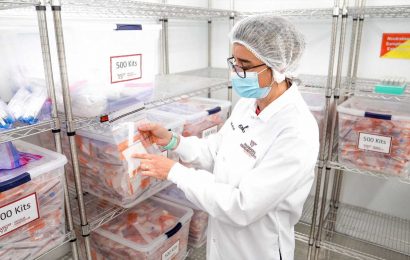Allergic trajectories occur in clusters, are affected by early life, genetics, and clinical traits, and don’t change much after 18 years of age, a new study from Europe reports.
“Seven robust allergic clusters were identified and showed associations with early life and genetic factors as well as clinical characteristics,” lead study author Anna Kilanowski, MSc, of the German Research Center for Environmental Health in Neuherberg, Germany, and her co-authors write in Allergy.
Allergic diseases such as asthma, atopic dermatitis, and rhinitis often develop together during early childhood, but they differ in their timing of onset, remission, and progression. Their development over time is often difficult to predict, and their determinants are not well understood, the authors explain.
To investigate how allergies develop over time and what factors predispose children to allergies, Kilanowski and her colleagues obtained data from two prospective, population-based German birth cohort studies that focused on allergic disease development: GINIplus (German Infant Nutritional Intervention study of the influences of nutrition intervention, air pollution, and genetics on allergy development), and LISA (of the influences of lifestyle-related factors on the immune system and the development of allergies in childhood in East and West Germany).
GINIplus included 5991 full-term, healthy newborns recruited in the Munich and Wesel areas in Germany between 1995 and 1998, and LISA included 3094 full-term, healthy newborns from the Munich, Wesel, Bad Honnef, and Leipzig areas in Germany born between 1997 and 1999. Both studies had comparable follow-up time points harmonized to 1, 2, 4, 6, 10, and 15 years.
The researchers used longitudinal k-means clustering to derive asthma, atopic dermatitis, and rhinitis trajectories in GINIplus and LISA, and they used multinomial models to estimate links with early life determinants, polygenic risk scores, food and aeroallergen sensitization, and lung function.
To replicate the results, they used the Swedish prospective, population-based birth cohort BAMSE study of risk factors for childhood asthma, allergic diseases, lung function, as well as factors that help predict already established disease, in 4093 newborns in the Stockholm area in Sweden recruited between 1994 and 1996 with follow-up at 1, 2, 4, 8, 12, and 16 years.
The Atopic March Is Not the Same in All Children
The authors identified seven allergic trajectories. The highest relative risk ratios (RRRs) for all seven trajectories below were linked with the child having both parents with allergies
-
Intermittently allergic (RRR, 1.8; 95% CI, 1.4-2.4)
-
Rhinitis (RRR, 3.6; 95% CI, 2.5-5.1)
-
Early resolving dermatitis (RRR, 3.4; 95% CI, 2.3-5.1)
-
Mid-persisting dermatitis (RRR, 2.8; 95% CI, 1.7-4.5)
-
Multimorbid (RRR, 5.0; 95% CI, 3.1-8.0)
-
Persisting dermatitis plus rhinitis (RRR, 7.9; 95% CI, 3.9-15.9)
-
Early transient asthma (RRR, 15.9; 95% CI, 4.5-56.3)
For all these trajectories, the relative risk ratios were higher than those linked with the child’s sex, with having older siblings, bronchitis by age 3, or a cat or dog by age 4.
The trajectories and their links with genetic effects and clinical traits were similar to those in the BAMSE children.
Individualized Patient Management Is Important
“The atopic march is an important paradigm for understanding the natural progression of allergic diseases,” Jonathan Tam, MD, medical director of the Gores Family Allergy Center at Children’s Hospital Los Angeles, told Medscape Medical News.

Dr Jonathan Tam
“Classically, the march begins in infancy with atopic dermatitis and progresses to asthma and allergic rhinitis,” said Tam, who was not involved in the study. “While this concept has some utility in gauging a child’s risk of developing future allergic diseases, it is not perfectly reproduced across clinical groups. Clinicians see a considerable amount of variability in individual outcomes.
“This study helps define the outcomes of early allergic disease and the reasons for the heterogeneity of atopic march trajectories,” Tam added by email. “The results of this study are consistent with those found in previous data sets.”
The study’s long follow-up and inclusion of genetic influences through polygenic risk score analysis are strengths of the study, he noted.
“These results help clinicians better forecast their patients’ allergic trajectories and identify their risks for disease development,” he said. “And they may eventually help them implement prevention strategies.
“The enduring questions are, ‘Which patients need close surveillance for the development of further allergic disease,’ and ‘How can disease development be prevented?'” he added.
David A. Hill, MD, PhD, FAAP, FACAAI, attending physician in the Division of Allergy and Immunology at Children’s Hospital of Philadelphia, welcomed the results.

Dr David A. Hill
“It is critically important that the allergy field move beyond assuming that all children develop allergic conditions along the prototypical path, and that we begin considering allergic march trajectories as distinct outcomes with potentially unique genetic and environmental determinants,” Hill, who also was not involved in the study, said by email.
“The potential for this area of research to impact clinical care is large and includes advances to primary prevention, patient risk stratification, diagnosis, and treatment,” he added. “The goal is to treat patients as the individuals they are and to tailor care plans based on individual risk, pathophysiology, and other personal considerations.”
Kilanowski, Hill, and Tam report no relevant financial relationships. Three study authors report financial relationships with pharmaceutical companies. The LISA and BAMSE studies were funded through non-commercial grants; GINIplus received non-commercial grants and support from pharmaceutical companies.
Allergy. Published online Sept. 7, 2022. Full text.
For more news, follow Medscape on Facebook, Twitter, Instagram, and YouTube.
Source: Read Full Article


